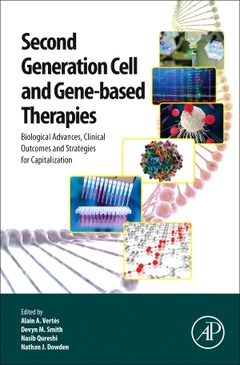Description
Second Generation Cell and Gene-Based Therapies
Biological Advances, Clinical Outcomes and Strategies for Capitalisation
Coordinators: Vertes Alain, Dowden Nathan J., Smith Devyn, Qureshi Nasib
Language: English
Subjects for Second Generation Cell and Gene-Based Therapies:
846 p. · 19x23.3 cm · Hardback
Description
/li>Contents
/li>Readership
/li>Biography
/li>Comment
/li>
PART 1 Science 1. Innovation S- Curves in Living Drugs Development and Their Commercialisation 2. Development and Deployment of Gene Therapies: An ADA- SCID Case Study 3. Therapeutic Potential of Cells of the Immune System 4. T Cell Engineering and the Rise of CAR- T Cell Therapies 5. Harnessing Natural Killer Cells’ Killing Function in Cancer 6. Pluripotent Stem Cell–Derived Islet Replacement Therapy for Diabetes 7. Harnessing in Silico Technologies to Develop and Augment Second- Generation Cell- Based Therapies 8. Second Generation Genome Editing Technologies in Drug Discovery 9. The Next Wave: Tissue Replacement and Organ Replacement 10. Combining Stem Cells and Materials for Nerve Tissue Regeneration
PART 2 Translation 11. Gene Therapy Clinical Trials: Past, Present and Future 12. CAR-T Cell Clinical Trials Experience – Past, Present and Future 13. T Cell Receptor Engineered T Cell Therapy in Oncology 14. Cytotherapy Clinical Trials in Genetic Disorders of the Blood and Options for Reimbursement
PART 3 The Next Frontier 15.Mesenchymal Stromal Cell Therapies – The Next Frontiers 16. Regenerative Medicine and Ageing: Is Senescence Reprogrammable? 17. Deciphering the Systems Architecture of the Brain Using Molecular Can Openers 18. Harnessing the Therapeutic Potential of Dendritic Cells 19. Brief Overview of Chimeric Antigen Receptor–Mediated Immunotherapy for Glioblastoma Multiforme 20. Combination Therapies in Solid Tumour Oncology
PART 4 Perspectives 21. Gene- Editing Technologies in Adoptive T Cell Therapy for Cancer: An Ethical Analysis 22. Decisions in the Development Lifecycle of Cell and Gene Therapies 23 CAR- T: From Concepts to Products – Now What? 24. Strategic Alliances in Cytotherapies and Gene Therapies: Funding the New Wave of Cell Therapeutics 25. The Role of Governments in the Commercial Emergence of Radical Innovation: The Case of the United Kingdom 26. Patenting Trends in Chimeric Antigen Receptor Technologies 27. Reimbursement and Payment Models for Therapies With Transformative and Curative Intent 28. Commercialising CAR- T Therapies: The Evolution of a Revolution 29. Will You Move the Needle of Medicine?
Scientists and students in stem cell biology, pharmaceutical science, regenerative medicine, cancer research, clinical trials, gene therapy, corporate strategists & investors in these fields
• Sloan Fellow from London Business School and a microbiologist by training (University of Illinois at Urbana-Champaign, Institut Pasteur Paris, and University of Lille Flandres-Artois).
• Consulting, Partnering & Fund Raising, Founder, Managing Director, NxR Biotechnologies, Switzerland.
• Dr. Vertès is a strategy and business development consultant for cell therapeutic biotech companies, and works to enable seed funding in the field. Focusing on technology deployment and innovation commercialization, he has contributed to both industrial and pharmaceutical biotechnology, in different functions including research, manufacturing, contract research, and strategic alliances in pharmaceuticals (Lilly, Pfizer, Roche).
• Championed radical innovation for bringing to patients disease-modifying, paradigm-changing therapeutics such as siRNA, and led in a scientific and business manner Roche’s global cell therapeutics strategy and implementation team resulting in Roche’s entry in 2010 in the field of regenerative medicine.
• Member, Industry Committee-Europe, Tissue Engineering and Regenerative Medicine International Society
• Co-Editor, Stem Cells in Regenerative Medicine: Science, Regulation and Business Strategies (Wiley, 2015).
• Head of Operations & Strategy, Medicinal Sciences Division of R&D, Pfizer Inc.
• Responsible for all cell & gene therapy products, as well as previously developing Pfizer’s Regenerative Medicine program.
• PhD in Genetics from Harvard Medical School.
• Adjunct faculty member at Northeastern University.
Research Chemical/Biochemical Engineer, United States Department of Agriculture (USDA), Agricultural Research Service (ARS), National Center for Agricultural Utilization Research (NCAUR), Peoria, IL, USA.
PhD (Chemical/Biological Engineering), PhD (Fermentation Technology)
Fellow in American Institute of C
- Helps readers learn about the most current trends in cell-based therapy, their overall effectiveness from a clinical prospective, and how the industry is moving therapies forward for capitalization
- "Perspectives" section at the end of each chapter summarizes key learnings, hypotheses, and objectives highlighted and combines scientific and business insights
- Edited and authored by scientists representing both basic and clinical research and industry, presenting a complete story of the current state and future promise of cellular therapies
These books may interest you

Stem Cells and Cell Therapy 105.49 €

Stem Cells and Cell Therapy 105.49 €


